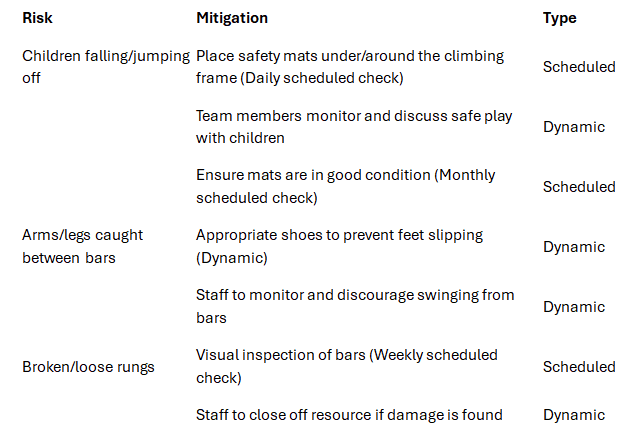When you identify a risk, it’s tempting to ask: “How do we make this go away?” But in early years, care, and activity settings, risk isn’t always something to be eliminated — it’s something to be managed thoughtfully. At Tudu, we believe risk management is about balance: creating safe environments while still allowing children to explore, develop, and grow.
Two simple questions guide every decision:
1. How much of a danger is this risk?
2. What is the benefit to the children of the activity or resource?
Children are naturally risk curious. While you and I know a jump from the climbing frame might end badly, children are still learning their own boundaries. As educators and coordinators, our job is to help them navigate that experience safely — not remove it entirely.
For example, the immediate reaction to a potential “child falling from a climbing frame” might be to remove the equipment altogether. That’s one way to eliminate the risk — but it also removes a valuable learning opportunity. Climbing frames help children develop gross motor skills, confidence, and problem-solving abilities.
Balance is key: a 4-foot climbing frame may be appropriate; a 15-foot one in a preschool room probably isn’t.
Common risks with a climbing frame might include:
1. Children falling or jumping off and injuring themselves.
2. Arms or legs getting caught between the bars.
3. Broken or loose rungs on the ladder.
Now that the risks are identified, the question becomes: how can we keep the resource while reducing harm?
In our example, the learning opportunity for preschoolers is worth preserving — so we look at how to mitigate the risks rather than eliminate the resource.
Mitigation reduces the likelihood of an accident or the severity if one occurs. In learning environments, total risk removal is rarely possible, and children learn best by exploring and pushing their boundaries.
In Tudu, you can apply three types of risk mitigation: Ad-Hoc, Scheduled Checks, and Dynamic Controls (you can read more about each here).
Because our climbing frame is always in use, we would rely mainly on scheduled checks and dynamic controls:

By layering these mitigations — scheduled inspections, staff interventions, and environmental changes — you create a safety net.
Having control tasks in place is a strong start, but sometimes they’re not enough. You may discover while completing your control tasks or throughout your work day:
· An outdoor climbing frame with structural damage.
· An activity space where exits are blocked.
· A piece of equipment repeatedly causing injuries despite checks.
In these cases, no number of mitigations beats a professional decision to stop the activity or remove the resource temporarily. Eliminating risk should be the last resort — but it’s sometimes the right one. to get the resource or activity back into the room as soon as possible, communicating problems with management is key to restoring activities quickly. In Tudu, team members can log an ‘issue’ directly to managers through their Tudu checklist, ensuring the activity or resource returns to use as soon as it’s safe.
Risk is unavoidable. What matters is your approach:
· Recognise hazards.
· Apply the right level of mitigation.
· Remove only when necessary.
· Embrace positive risk as a tool for growth.
In doing so, risk assessments become more than paperwork. They become a living framework that keeps people safe while opening the door to richer experiences.